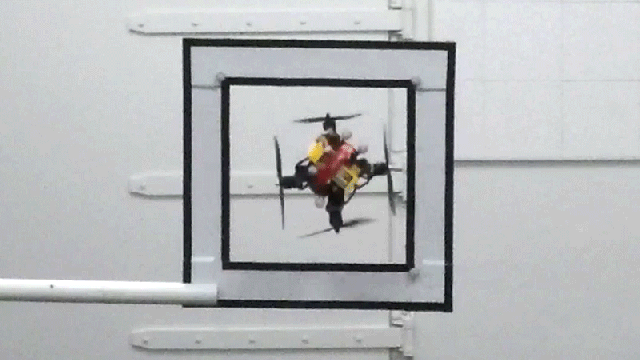We’ve come up with a lot of unique ways to use drones — from scorching the earth to delivering food — but one of the most common is for reconnaissance or search and rescue missions where it’s unsafe for humans to venture.
That can include the occasional cramped space where drones normally can’t fit, but a new design lets them temporarily shrink to squeeze through tight spaces.
[referenced url=”https://gizmodo.com.au/2019/06/a-tiny-drone-carrying-a-deconstructed-gopro-captured-this-incredible-dinosaur-museum-fly-through/” thumb=”https://i.kinja-img.com/gawker-media/image/upload/t_ku-large/xdnqo0o8unx3vcfbfcca.gif” title=”A Tiny Drone Carrying A Deconstructed GoPro Captured This Incredible Dinosaur Museum Fly-Through” excerpt=”It’s one thing to pilot a drone along a picturesque coastline, capturing breathtaking footage you could never get on the ground. But it takes an entirely different level of skill to pilot a drone through intricate dinosaur skeletons inside a museum.”]
This “Passively Morphing Quadcopter”, as a research team from UC Berkeley’s High Performance Robotics Laboratory (HiPeRLab) calls it, isn’t the first quadcopter that can reconfigure its shape mid-flight. But it is the first that can do it without the need for any additional powered hardware that could put an extra drain on the craft’s battery life, reducing flight times.
The quadcopter’s four outstretched arms — each of which has an electric motor and propeller on the end — are attached to the craft’s main body with hinged joints. On the underside of each arm is a simple spring that’s always under tension, so when the craft is powered off, they pull each arm down which helps reduce the overall footprint of the craft.
But the springs aren’t terribly strong, and when the craft roars to life, the lift generated by each propeller is more than enough to overcome the tension, cause all four arms to swing upwards and fully extend.
When approaching an opening that’s smaller than the drone when its arms are extended in flight, like a tiny window, it can automatically plot a course and trajectory so that just before it passes through the obstacle, its rotors turn off causing the arms to retract so it can easily squeeze through.
The drone’s momentum carries it through to the other side, at which point the rotors can spin up again, the arms can extend, and the craft can stabilise itself before continuing exploring.
There are a few more obstacles before we see tricks such as this being employed in real-world situations.
It could work with a skilled pilot at the controls who has access to a first-person view from the drone through VR goggles, but asking a quadcopter to perform this manoeuvre all by itself would require some complicated analysis and trajectory plotting all by itself. And the UC Berkeley team hasn’t tackled that just yet.
The trick is also only useful for temporarily passing through areas with a tight fit. As soon as this manoeuvre starts and the drone collapses, it starts falling out of the sky as its propellers are no longer providing thrust. It requires plenty of space on the other side to power back up, recover and steady itself before continuing its explorations.
Trying to fly through a long, cramped ventilation shaft like John McClane did in Die Hard just isn’t going to happen.
